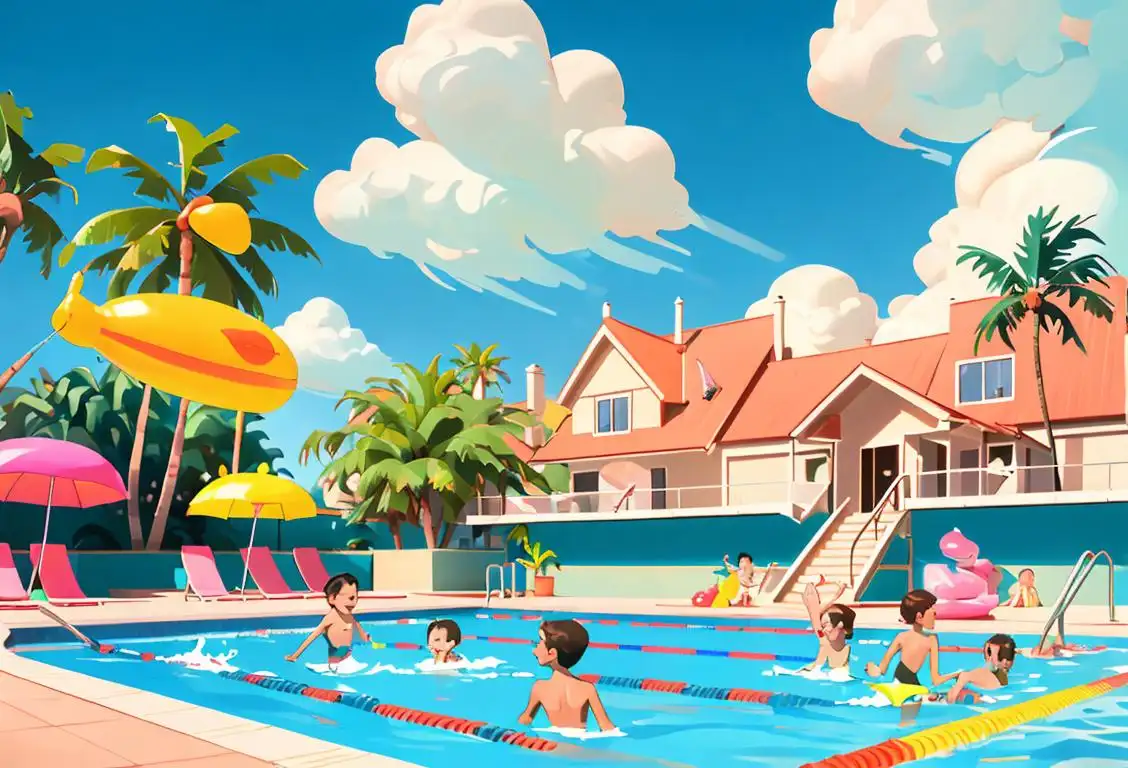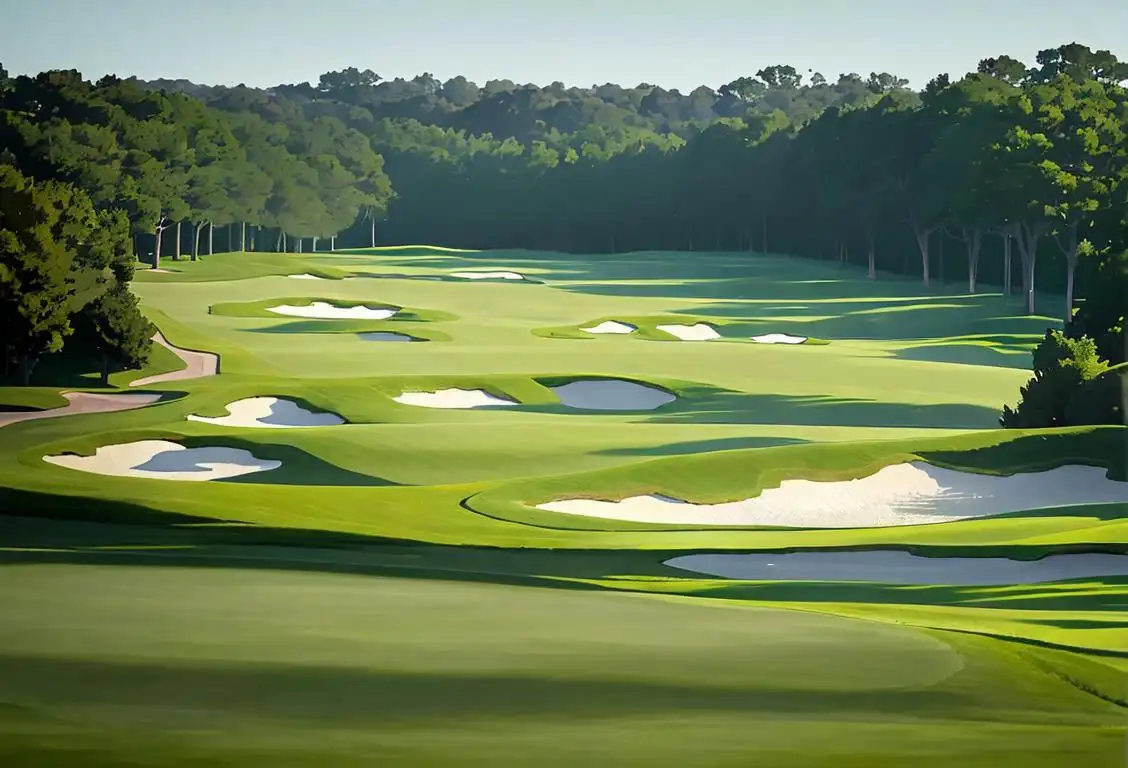National Swimming Pool Day

Welcome to the wonderful world of National Swimming Pool Day! Get your goggles, floaties, and dashing bathing suit ready because it's time to make a splash. Whether you're a serious swimmer gunning for gold or just love to dip your toes in the water, this day is dedicated to celebrating all things swimming pool.
When is Swimming Pool Day?
It's national swimming pool day on the 11th July.
The Internet History of National Swimming Pool Day
Let's dive into the internet history of National Swimming Pool Day, shall we? Back in the early days of the web, people didn't have easy access to information about quirky national days. Can you imagine a world without that delightful knowledge? We can't either!
However, as the internet evolved and grew, more and more sites dedicated to national days started popping up. And one of these sites discovered a curious gap in the celebration calendar—there was no dedicated day for one of the greatest summer pastimes: swimming pools. Outraged by this injustice, they decided to create National Swimming Pool Day.
With a few clicks, taps, and some colorful HTML, National Swimming Pool Day was born. The news spread like a ripple on calm water, and people across the globe finally had a day to honor the joy of swimming in pools.
Fun Ways to Celebrate
Now that we know a bit about the internet history of National Swimming Pool Day, let's move on to the fun part: how to celebrate this splashtastic day! Here are a few ideas to help you make the most of this amazing occasion:
- Host a Pool Party: Invite friends, family, and random strangers to come and enjoy a day of poolside fun. Don't forget to stock up on refreshments and sunscreen!
- Try a New Pool Game: If you're tired of the usual cannonball competitions, why not mix things up with some pool volleyball, Marco Polo, or a thrilling game of Sharks and Minnows?
- Float Away: Embrace your inner relaxation guru by lounging on a pool float, soaking up the sun, and imagining you're on a tropical vacation. Bonus points if you have a fruity drink in your hand!
A Deeper Dive into Swimming Pool Facts
Did you know that the world's largest swimming pool is 1,013 meters long? That's roughly equivalent to 10 Olympic-sized swimming pools! Located in San Alfonso del Mar resort in Chile, this ginormous pool offers plenty of space for swimmers to show off their impressive strokes.
Another fun fact: the first above-ground swimming pool was invented in 1907 by a gentleman named Ernest Kasper. His brilliant creation gave people the opportunity to enjoy the pleasures of swimming even if they didn't have a backyard or a big budget.
So, as you can see, swimming pools have a rich history and have brought joy to countless people throughout the years. National Swimming Pool Day is a chance to celebrate and honor these refreshing oases of aquatic delight.
History behind the term 'Swimming Pool'
2600 BC
Ancient Baths
Ancient civilizations in the Indus Valley and ancient Egypt built bath houses that resemble modern-day swimming pools. These ancient baths served as communal gathering places for bathing, socializing, and religious ceremonies. They were often adorned with beautiful decorations and statues, showcasing the importance of water in their cultures.
2500 BC
Ancient Beginnings
The concept of swimming pools can be traced back to ancient civilizations. The first known pool-like structure dates back to around 2500 BC in the ancient city of Mohenjo-daro, now part of modern-day Pakistan. These early pools were rectangular and made of brick and were used for religious ceremonies and bathing purposes.
2600 BC
Ancient Origins
The ancient civilizations of Mohenjo-daro and Harappa in the Indus Valley (located in present-day Pakistan) had the first known swimming pools. These early pools were created with bricks and lined with tar to make them waterproof. They were used for religious ceremonies, bathing, and as a form of leisure activity. The pools were surrounded by steps to allow easy access.
2600 BCE
Early proto-pools
Archaeologists have discovered evidence of early swimming pools in the ancient ruins of the Mohenjo-daro civilization in the Indus Valley. These proto-pools were rectangular in shape and made of bricks and tar. It is believed that they were used for religious and ceremonial purposes rather than for recreational swimming.
2600 BCE
Ancient Beginnings
The concept of swimming pools can be traced back to the ancient civilizations of the Indus Valley in present-day Pakistan. Archaeological evidence suggests that the people of this highly advanced civilization had large public water tanks known as 'great baths.' These were likely used for ritualistic bathing and swimming, making them the earliest known precursors to modern swimming pools.
1st century AD
Roman Influence
During the Roman Empire, the concept of the swimming pool became popular. Romans constructed large public and private pool complexes known as 'natationes.' These pools were made of stone or marble and filled with both freshwater and seawater. Swimming became a popular sport, and the Romans also used pools for therapeutic purposes.
1st century BCE
Roman Baths
During the Roman Empire, the concept of public bathing became widespread, and magnificent bathhouses known as thermae were constructed. These bathhouses often featured large pools for swimming and exercising. Romans believed in the therapeutic and social benefits of swimming, and these pools were a popular gathering place for both the wealthy and the common people.
3rd Century BC
Greek and Roman Influence
The ancient Greeks and Romans also had their version of swimming pools. The Greeks built large public baths called 'piscinae' for recreational and therapeutic purposes. In Rome, both the rich and the famous built lavish private pools known as 'piscinae natatoria', which were often adorned with beautiful statues and fountains.
700 BCE
Greek Influence
After the ancient Indus Valley civilization, the Greeks further developed the idea of public bathing. They constructed magnificent pools, known as 'piscinae,' using elaborate hydraulic systems to fill them with both fresh and saltwater. These pools became a central part of their social and recreational activities, providing a place for exercise and relaxation. The Greeks also introduced the concept of swimming as a competitive sport, fostering the growth of pool-based athletic events.
1st Century BC
Roman Piscinae
The Romans took the concept of communal bathing to new heights with their elaborate public baths called 'piscinae.' These structures featured large swimming areas, known as 'natationes,' which were rectangular in shape and filled with water. The Roman pools were often fed by natural springs or heated by a complex system of underground furnaces, demonstrating the engineering prowess of the time.
19th century
Privileged Victorian swimming
With the advent of the Industrial Revolution in the 18th century, the affluent upper class sought ways to escape the polluted cities. Many wealthy individuals began constructing private swimming areas known as swimming ponds or bathing pools on their estates. These were often natural bodies of water modified to create a more controlled swimming environment.
19th Century
First Modern Pools
The modern concept of private swimming pools began to emerge during the 19th century. Wealthy individuals in Europe and America constructed their own private pools on their estates. These early pools were often irregularly shaped and made of materials such as marble or concrete. They were primarily used for exercise and leisure by the aristocracy.
1st Century CE
Roman Innovations
During the Roman Empire, swimming pools took on even greater significance. The Romans built large and luxurious private swimming pools, known as 'natationes,' as well as immense public pools that were part of their grand bath complexes, called 'thermae.' These complexes were equipped with heating systems and included various pools of different temperatures, creating a truly indulgent and opulent bathing experience.
19th century
Evolution of Modern Pools
In the 19th century, advancements in materials and engineering led to the development of modern swimming pools. The industrial revolution brought about innovations such as cast iron, which replaced the cumbersome stone and marble construction. Additionally, the introduction of water filtration systems improved hygiene and water quality in pools, making them more accessible to the general public.
8th Century AD
The Islamic Tradition
During the Islamic Golden Age, from the 8th to the 14th century, many beautiful palace complexes, known as 'Alhambra', were constructed in Spain. These complexes featured stunning gardens with ornate pools and fountains, showcasing the Islamic love for water and the use of pools as sources of beauty and tranquility.
19th Century
The Modern Era
The concept of swimming pools as we know them today emerged in the 19th century. Industrialization and advancements in technology made it possible to construct larger, more elaborate pools. The first ever indoor swimming pool, called the Deep Eddy Pool, was constructed in Austin, Texas in 1915, sparking the trend of building public swimming pools across the United States.
20th century
Backyard Pools and Public Attractions
In the early 20th century, the popularity of swimming pools grew, and they started to appear in people's backyards. The spread of suburban living and the rise of the middle class contributed to this trend. As the demand for recreational swimming increased, public pools, water parks, and aquatic centers began to emerge as popular destinations for families and individuals seeking leisure and exercise.
1837
Boston's first public swimming pool
The first public indoor swimming pool in the United States opened in Boston in 1837. Known as the 'Floating Swimming Bath,' it was a large wooden structure located on the Charles River. This innovation allowed people of all social classes to enjoy swimming, marking a significant shift toward the democratization of swimming opportunities.
19th Century
The Modern Pool Emerges
While swimming pools had been present throughout history, it was in the 19th century that the basis for the modern swimming pool was established. As cities grew and public health awareness increased, the need for clean recreation spaces became apparent. The first public swimming pool, known as the 'Sandford Manor Pool,' opened in London in 1837. This marked the beginning of a new era, with the construction of purpose-built pools that included filtration systems to maintain water quality.
20th Century
Pool Popularity
As the popularity of swimming grew, so did the demand for public swimming facilities. The early 20th century saw the construction of public swimming pools in various countries, offering accessibility to a wider range of people. The first public swimming pool in the United States, the Deep Eddy Pool in Texas, was built in 1915. These pools marked a shift toward utilizing swimming as a recreational activity for the general public.
20th Century
The Rise of Backyard Pools
In the 20th century, swimming pools became popular additions to private residences. The post-World War II era saw the rise of affordable, portable above-ground pools, allowing more families to enjoy the luxury of having their own swimming pool. The popularity of backyard pools further grew with the development of more advanced pool filtration and maintenance systems.
20th Century
Pool Popularity Soars
With advancements in technology and changes in societal attitudes towards leisure and health, swimming pools became increasingly popular in the 20th century. The introduction of chlorine as a disinfectant, the development of pool cleaning systems, and the availability of affordable construction materials contributed to the widespread proliferation of swimming pools in both public and private spaces. Swimming pools became a symbol of recreation, socializing, and athletic achievement.
20th century
Modernization and standardization
Advancements in materials and technology during the 20th century led to the development of modern swimming pool construction and maintenance practices. Reinforced concrete became the material of choice, and filtration and disinfection systems were introduced, making swimming pools safer and more hygienic. The Olympic Games also played a significant role in popularizing swimming and the construction of specialized competition pools.
Modern day
Architectural Marvels and Design Trends
In the modern era, swimming pools have become architectural marvels and design statements. The development of new materials such as fiberglass and reinforced concrete opened up new possibilities for pool construction. Creative designs like infinity pools, rooftop pools, and natural pools are now prevalent. Swimming pools continue to be a symbol of luxury, relaxation, and recreation in many cultures around the world.
1950s
Backyard Boom
In the post-World War II era, the construction of backyard swimming pools surged, particularly in the United States. Affluent suburban families sought to have their own private pools as a symbol of status and to provide a recreational space for their children. The advent of affordable and accessible pool technologies, such as vinyl liners and filtration systems, made backyard pools more attainable for the middle class.
Present Day
Diverse Varieties
Today, swimming pools come in various shapes, sizes, and designs. From Olympic-sized pools to infinity pools with breathtaking views, and from natural pools that blend with the environment to high-tech indoor pools, the options are diverse. Swimming pools have become an integral part of recreational activities, sports training, and a symbol of status and luxury.
Present Day
Diverse Pool Designs
Today, swimming pools come in a plethora of designs and types. From traditional rectangular pools to infinity pools, Olympic-sized pools to backyard leisure pools, and even natural pools that blend harmoniously with the surrounding environment. The popularity of swimming pools continues to grow, providing people around the world with a refreshing and enjoyable way to beat the heat and engage in various water-based activities.
Present
Swimming pool as a cultural icon
Today, swimming pools have become an integral part of leisure, recreation, and sports around the world. From residential pools to water parks and Olympic-sized facilities, swimming pools cater to a wide range of interests. They symbolize relaxation, exercise, and fun, and have become a cultural icon associated with summer, vacations, and the pursuit of an active and healthy lifestyle.
21st Century
Innovation and Design
Advances in pool technology and design have continued into the 21st century. Today, swimming pools come in various shapes, sizes, and features, including infinity pools, Olympic-sized pools, and even rooftop pools. Innovative materials, such as fiberglass and composite materials, have made pool construction more efficient and durable. Additionally, eco-friendly practices, such as solar heating systems and saltwater chlorination, have gained popularity, reflecting society's growing environmental consciousness.
Did you know?
Did you know that the world's largest swimming pool is 1,013 meters long? That's roughly equivalent to 10 Olympic-sized swimming pools!Tagged
fun property sportsFirst identified
11th July 2016Most mentioned on
11th July 2019Total mentions
239Other days
Caregivers Day
Family Day
Action Day
Opposite Day
One Day
Awareness Day
Golf Course As Trump Departed After His Second Consecutive Day
Happiness Day
Suicide Prevention Month Day
Believe Day









